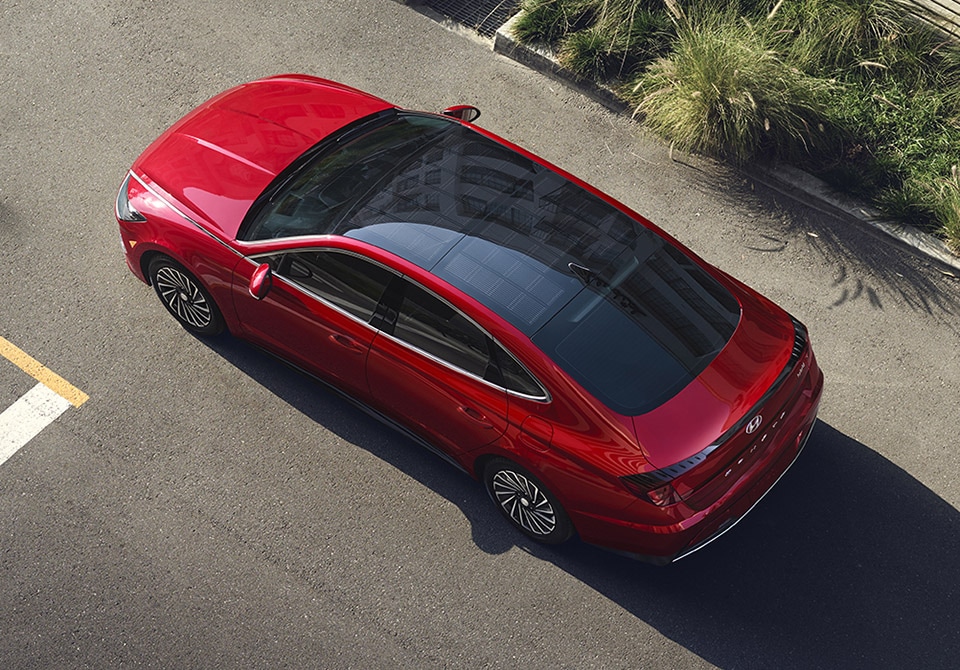The widest range of electrified vehicles in Canada.▲
There is a lot to consider when it comes to shopping for an alternative powertrain vehicle. Is electric the right choice for you? Maybe a hybrid? What is a fuel cell?
At Hyundai, we have the widest range of electrified vehicles in Canada.▲ Take a look below to learn a bit more about how each powertrain works and find the one that is right for you.
Hyundai offers vehicles in four alternative powertrains.
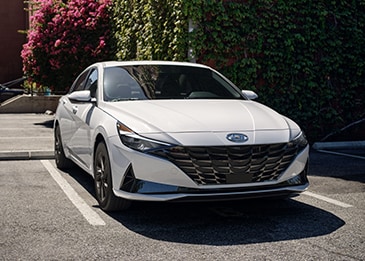
Hybrid
The most accessible of the powertrain options, our hybrid vehicles offer driving fun with lower emissions that can meet the needs of your daily commute and weekend adventures.
Learn More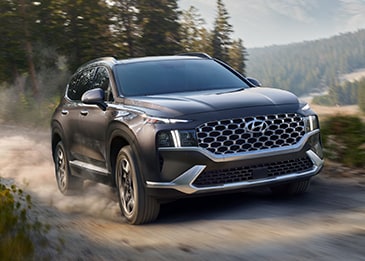
Plug-in Hybrid
Electric when you want it. Gas when you need it. Enjoy the best of both worlds with a plug-in hybrid powertrain. These powertrains feature a larger battery compared to a hybrid, which gives you the option to drive on electric power only for shorter trips. If you need to go farther, the plug-in hybrid powertrain will simply start using the gasoline engine like a traditional hybrid.
LEARN MORE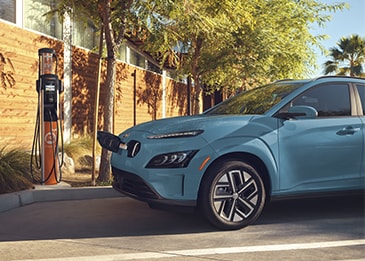
Electric
Operating solely on electric power, an electric powertrain produces zero driving emissions. Our electric vehicle lineup offers an exceptionally impressive driving range. Charge from home or at work, and never stop for gas.
LEARN MORE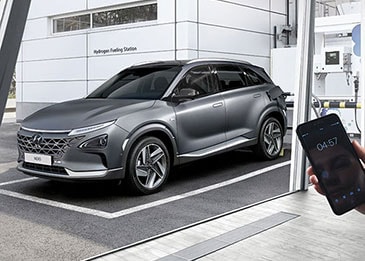
Fuel Cell
A fuel cell electric vehicle, like the Hyundai NEXO, is an electric vehicle that powers through an electrochemical process, combining hydrogen and oxygen gases in a fuel cell stack. The only exhaust emission is pure water vapour.
LEARN MOREChoosing an alternative powertrain offers many benefits to you and the environment.
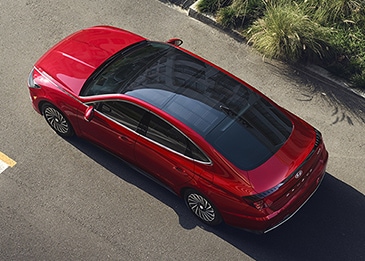
Government Incentives
Based on where you live and which powertrain you are purchasing, you may be eligible for various regional, provincial and federal government incentives^.
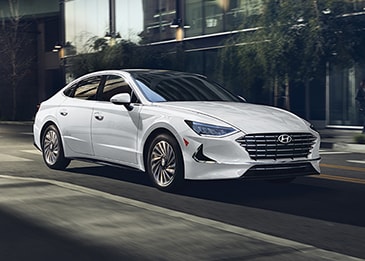
HOV Lane Access
In some provinces, having a Green Vehicle licence plate grants you access to convenient High Occupancy Vehicle (HOV) lanes as a solo driver.
*Details regarding certain benefits provided to drivers of electric, plug-in electric and/or hybrid vehicles by third party government, municipal or other entities (“Benefits”) are set forth herein for informational purposes only and may be changed or canceled at any time, without notice. The availability, nature and/or extent of any Benefit, and its eligibility or application may vary from jurisdiction to jurisdiction. Benefits are administered independently by each applicable entity and are subject to cancellation or change. Hyundai Auto Canada Corp. is not responsible for the administration of Benefits, nor any changes or cancellations thereto, and makes no representations about any Benefit. Conditions and limitations apply. Consult the applicable jurisdiction for details on any applicable Benefits.
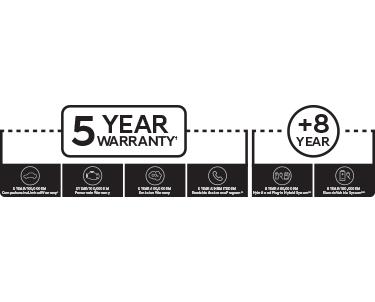
8-Year Warranty
In addition to our outstanding warranty program, we also back the quality of our alternative powertrains with an additional 8-year/160,000 kilometre warranty.
• 5 YEAR/100,000 KM
Comprehensive Limited Warranty†
• 5 YEAR/UNLIMITED KM
Roadside Assistance Program††
• 8 YEAR/160,000 KM
Hybrid and Plug-in Hybrid System†††
• 8 YEAR/160,000 KM
Electric Vehicle System††††
†Hyundai’s Comprehensive Limited Warranty coverage covers most vehicle components against defects in workmanship under normal use and maintenance conditions.
††Hyundai’s 24-Hour Roadside Assistance Program is a limited service and does not cover certain costs or expenses. Roadside Assistance is not a warranty.
†††Hybrid System includes Hybrid Battery Pack Assembly, Hybrid Starter and Generator, Hybrid Power Control Unit, Auto Transmission including Traction Motor.
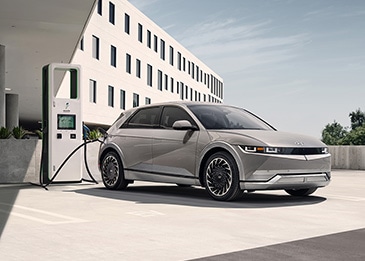
Exclusive Parking Spaces and Charging
Many parking lots across Canada feature exclusive spots for your electric vehicle to park and charge.
*Details regarding certain benefits provided to drivers of electric, plug-in electric and/or hybrid vehicles by third party government, municipal or other entities (“Benefits”) are set forth herein for informational purposes only and may be changed or canceled at any time, without notice. The availability, nature and/or extent of any Benefit, and its eligibility or application may vary from jurisdiction to jurisdiction. Benefits are administered independently by each applicable entity and are subject to cancellation or change. Hyundai Auto Canada Corp. is not responsible for the administration of Benefits, nor any changes or cancellations thereto, and makes no representations about any Benefit. Conditions and limitations apply. Consult the applicable jurisdiction for details on any applicable Benefits.
Frequently Asked Questions
A hybrid electric vehicle and a plug-in hybrid electric vehicle both utilize their powerful electric motor and a gasoline engine to generate movement. They adapt on their own using both the electric motor and gasoline engine simultaneously based on the current driving conditions. Both vehicles also use regenerative braking, the most efficient way of putting energy back into the electric battery. This is the process of recovering energy that would otherwise be lost during deceleration so it can be reused to propel the car once acceleration is required. The key differences between the two is that the plug-in hybrid has a larger electric motor and greater battery capacity allowing it to be used for a greater range of operation and distance. The plug-in hybrid plugging into an external electric source while the standard hybrid is solely fueled like a conventional gasoline vehicle.
A Hybrid vehicle uses both a gasoline engine and electric motor for propulsion. An electric vehicle uses only an electric motor for propulsion – no gasoline required. The electric vehicle’s high-density battery needs to be periodically charged through an external electrical power source.
No. Hybrid vehicles automatically charge when they’re in motion and, through a clever innovation called regenerative braking, which recovers energy that would otherwise be lost during deceleration.
When it comes to long commutes, a hybrid vehicle provides better efficiency in all driving conditions in comparison to a standard petrol or diesel vehicle. You can reap all of these same benefits with a plug-in hybrid with the added ability to travel up to 45 km (IONIQ Electric Plus and Sonata Plug-in Hybrid) on using purely electric power. This capability is best suited for inner-city commuting. For example, many drivers could likely cover their entire week’s commuting using electricity alone with overnight recharging, all the while maintaining the ability to tackle long distances on the weekend. A plug-in hybrid would serve best for longer drives, given its ability to fully utilize the battery before switching to a traditional hybrid to go even farther. For example, the IONIQ electric plus can travel over 1,000 km on a single charge and tank of gasΩ.
For shorter city commuting, which often involves a lot of stop-and-go driving, a fully electric powertrain would serve best. It will produce zero emissions while effortlessly getting up to speed. As well, the energy generated from braking can be recaptured and used to recharge the vehicle’s battery through an innovative process called regenerative braking.
Resources for Electric & Plug-in Hybrid
^Federal and provincial electric vehicle incentives (each an "Incentive") each represent a maximum incentive or rebate amount provided by the federal government and the provincial governments of British Columbia and Quebec (each a "Jurisdiction") on eligible vehicles. The amount of the Incentive, its terms and conditions, and its eligibility or application varies by Jurisdiction, model and trim level, MSRP, payment method, term, and any other criteria that may be established by each Jurisdiction. Incentive applied after applicable taxes in Quebec, British Columbia and federally. The Incentive programs are administered independently by each Jurisdiction and are subject to cancellation or change. Hyundai Auto Canada Corp. is not responsible for the administration of Incentive programs, and any changes or cancellations thereto, and makes no representations about the actual amount or eligibility for the Incentive. Incentive information is provided for informational purposes only. Conditions and limitations apply. Consult the applicable Jurisdiction or see your dealer for detail.
▲Claim based on Autoplanner comparison as of August 2021. Hyundai Auto Canada Corp. is the only OEM in Canada to currently offer customers the option of four alternative powertrains, namely hybrid, electric, plug-in hybrid and fuel cell.
ΩTotal Driving range of 1002 kilometers based on a 43 litre tank and 4.5L/100km combined fuel economy for a 955 kilometre Gasoline driving range plus the all-electric driving range of 47 kilometers* for the 2019 IONIQ Plug-in Hybrid Ultimate model. Fuel economy figures are based on manufacturer’s testing and are used for comparison purposes only. Actual fuel efficiency may vary based on driving conditions and the addition of certain vehicle accessories. . All-electric driving range of 47 kilometers based on a battery capacity of 8.9 kWh and battery usage rate of 2.0Le/100km for the 2019 IONIQ Plug-in Hybrid Preferred model.
†Hyundai’s Comprehensive Limited Warranty coverage covers most vehicle components against defects in workmanship under normal use and maintenance conditions.
††Hyundai’s 24-Hour Roadside Assistance Program is a limited service and does not cover certain costs or expenses. Roadside Assistance is not a warranty.
†††Hybrid System includes Hybrid Battery Pack Assembly, Hybrid Starter and Generator, Hybrid Power Control Unit, Auto Transmission including Traction Motor.
††††EV System includes motor, inverter unit, VCM, reduction gear, DC/DC converter, onboard charger and connector, trickle charge cable, in cable control box and high voltage battery.


